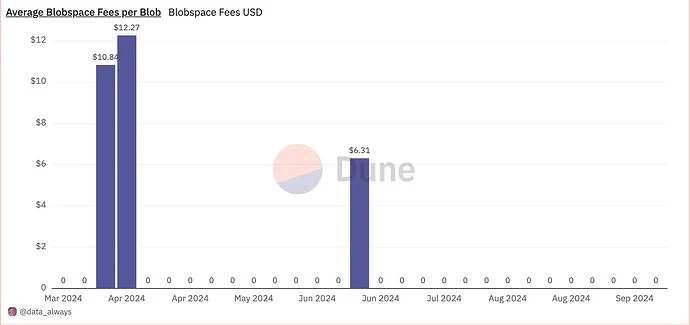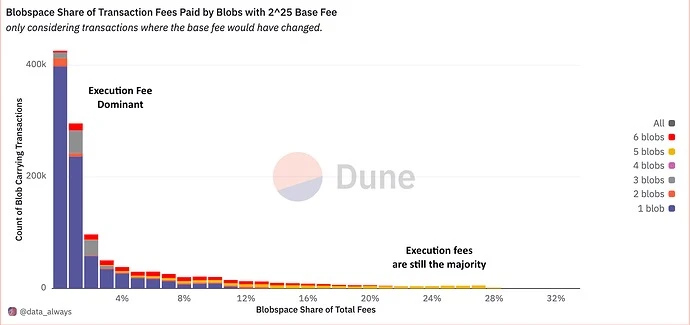Original text: Understanding Minimum Blob Base Fees
Original author: Data Always - Flashbots Research
Compiled by: Odaily Planet Daily Husband

Data Always, a researcher at Flashbots Research, published an article to demonstrate whether increasing the minimum basic fee for Blob affects the cost of existing L2 or related transactions. The article summary is as follows:
The setting of the Blobspace reserve price has sparked controversy in the community, partly due to a misunderstanding of Blob’s path on the chain. Although it is currently believed that Blob’s contribution to the protocol is zero, this view is only valid when analyzing Blobspace fees.
Blob-carrying transactions still need to pay mainnet gas fees, and during periods of high demand, the impact of gas priority auctions makes L2 transaction pricing more complicated.
This article demonstrates whether the mismatch between price and demand can be alleviated by increasing the minimum base fee for Blob.
Overall, this adjustment will have limited impact on transaction costs, especially for efficient blob submitters, the fee increase will be minimal.
The following is the original text, translated by Odaily Planet Daily
The proposal for how to set the blobspace floor price is controversial in the community , but this may stem from a misunderstanding of how blobs find their way on-chain. It is generally believed that blobs currently contribute zero to the protocol, but this is only true if we limit our analysis to blobspace fees. Established at that time.
Although the blobspace fee market has been slow to reach target demand levels, suffering from the cold start problem predicted by Davide Crapis in Deneb a year earlier , but Blob-carrying transactions still pay mainnet gas fees , regardless of execution or execution priority. The current concern raised by Max Resnick is that the hard limit of six blobs per block, coupled with a slow response from the blobspace fee market, could lead to Long priority gas auctions occur during periods of high network demand. During these PGAs, L2 transaction pricing becomes more difficult, and strict blob mempool rules make blob inclusion unpredictable.
EIP-7762 8 aims to minimize the misalignment between future blobspace prices and Blob demand until L2 adoption allows us to overcome the cold start problem. The current configuration has a minimum Blobspace base fee set to 1 wei, which requires at least 30 minutes of full With saturated blocks, blobspace fees can reach $0.01 per Blob and start to affect Blob pricing dynamics. Under the current system, when demand surges, the network reverts to an unpredictable PGA as L2 fights for timely inclusion.
For example, on June 20, the network experienced its second blob reversal event , stemming from the LayerZero airdrop , during which excess demand for blobs persisted for six hours until the network reached equilibrium.

Current status of Blob transaction fees
Six months after Deneb went live, blobspace usage remains below target . As a result, blobspace base fees remain low, and most blobs incur negligible blobspace gas fees. To date, there have only been three weeks where the average cost of blobspace has increased. to over $0.01 per blob on March 25 and April 1, during the “blobscription” craze , and on June 17, during the LayerZero airdrop.

Compared to the fees in blobspace, Blob-carrying transactions (also known as Type-3) still require gas fees to be executed on the mainnet. Although gas prices have fallen to their lowest point in many years, the average execution fee per blob is around 0.50 These costs are minuscule compared to historical L2 posted call data prices , and blobs are essentially fully subsidized by the network, but they still matter when setting the minimum base fee for blobs.

If we further break down the execution costs of transactions carrying blobs, based on their blob content, we see that the market is highly heterogeneous. Transactions carrying only one blob pay the highest fees, while transactions carrying 5 or 6 blobs pay the highest fees. The transaction pays little to no fees per blob. In fact, the total fees paid for these five or six transactions are much lower .

The difference in blob submission strategies of different entities is one of the important reasons for this situation. Base, OP Mainnet and Blast, as well as many smaller L2s, are extremely financially efficient in publishing data to EOA, which requires execution of this strategy. The mainnet gas is only 21,000 regardless of the number of blobs, but these transactions are not suitable for fraud proofs. These chains account for the vast majority of transactions carrying five or more blobs, reducing the number of blobs required to submit a single transaction. In contrast, L2s that publish more complex data to better support fraud proofs, such as Arbitrum, StarkNet, Scroll, ZkSync Era, Taiko, and Linea, use significantly more mainnet gas , typically 100,0 ... Only one blob is submitted per transaction.
Based on the statistics above, if we combine the blobspace and execution fees per transaction, we see that, except for brief spikes in blob demand (which would not be affected by increasing the minimum base fee), the current blobspace distribution pays Almost all of it is concentrated in execution fees. This suggests that the blobspace fee market is not currently functioning properly, and there is a lot of room to increase the minimum fee for blob gas without significantly increasing the total cost of a blob payment.

In contrast, if we focus on the period when the blobspace fee market enters price discovery, fee density quickly shifts toward blobspace fees. When the market works, it seems to work well. Therefore, the most important issue is the recurring cold start problem - The current predicament facing the market.

When the blobspace fee market is in an execution fee-dominated environment, blob submitters who publish less execution data (primarily the OP Stack chain) benefit. It also complicates the block construction process: historically many algorithms have been Blob inclusion is determined by the priority fee of the transaction, but since the mainnet gas usage of these transactions varies greatly, it forces L2s that submit higher quality proofs to pay a higher rate for the majority of them. Larger transactions further amplify the The advantage of submitting less execution data. By approaching an environment dominated by blobspace fees, we will reduce this advantage.
Impact of minimum fees
At current ETH prices, Max’s original proposal set a minimum fee of $0.05 per blob. By supplementing execution costs with this new minimum fee, the proposal will increase the average cost per blob by 2%.
The revised proposal reduces the minimum blob base fee to 2^25, about one-fifth of the original proposal value, or $0.01 per blob. This means that the average cost of a blob has increased by 0.7% since the beginning of July. However, due to differences in financial efficiency among blob submitters, the percentage changes are not uniform across entities.
Modify the earlier per-transaction fee analysis to consider a minimum blobspace base fee of 2^25 wei, and only consider transactions where the original blobspace base fee is lower than the new proposed minimum fee. We see that while the fee structure is starting to change significantly, for For all affected blob-carrying transactions, the blob base fee remains a minority component. Efficient transactions (carrying five blobs) submitted by Base and OP Mainnet will see a 10% to 30% fee increase depending on L1 gas prices. The change should be easily absorbed. Less efficient transactions, especially those carrying one to three blobs, will see fee increases of less than 10%.

Table: Blob submission statistics by entity from July 1, 2024 to September 17, 2024, assuming an ETH price of $2,500.
Modifying the previous per-transaction breakdown to account for a minimum blobspace base fee of 2^25 wei, and only considering transactions where the original blobspace base fee is lower than the proposed new minimum fee, we see that while the fee structure is starting to change significantly, the Blob The base fee remains a small fraction of all affected blob-carrying transactions. Efficient transactions (carrying five blobs) submitted by Base and OP Mainnet will see a 10% to 30% fee increase depending on L1 gas prices. The change should be easily absorbed. Less efficient transactions, especially those carrying one to three blobs, will see fee increases of less than 10%.
To date, there are no Blob-carrying transactions where the minimum Blob base fee of 2^25 accounts for the majority of the payment costs of the exchange.

Blobspace response time
Under EIP-4844 , the maximum inter-block update of the blobspace base fee is 12.5%. Starting from a price of 1 wei, it takes 148 blocks of maximum capacity and more than 29 minutes (12 seconds of block time) for the base fee to increase. To 2^25 wei or more. This update period has been defined as the protocols response time, but it still only represents a minimum amount of time. Due to market inefficiencies, blocks are not fully loaded with blobs, significantly extending the time for price discovery.
Before the LayerZero airdrop on June 20, the blob base fee was at its lowest value of 1 wei. At its peak, the blob base fee reached 7471 gwei ($3,450 per blob). Although it is theoretically possible to reach this height in 51 minutes, , but the actual ascent took nearly six hours. Under Maxs proposal, this highest point could theoretically be reached in 21 minutes, but these theoretical values are obviously not accurate.
The goal of the proposal is to set the minimum blob base fee close to the turning point where blobspace fees begin to account for a measurable share of total fees, rather than focusing on time. On June 20, although the number of blobs began to surge after 11:00 UTC, But it wasnt until 15:17 UTC that blobspace fees began to account for 0.1% of the total fees paid by Blob, and it wasnt until 15:41 UTC that the base fee of 2^25 wei (0.0335 gwei) was exceeded.

In contrast, if the minimum base fee during the LayerZero airdrop is 2^25 wei, the network may skip the cold start problem and minimize the misalignment between price and demand. As shown in the figure below, we can predict the blob It will still take an hour or more for the market to normalize.

In summary, raising the minimum blobspace base fee is not a panacea, but it should be seen as a welcome change to the protocol. The market impact of the proposal should be minimal, with only the cheapest and lowest quality blobs seeing a price increase of more than 1%. , while still being significantly lower priced than its competitors.










